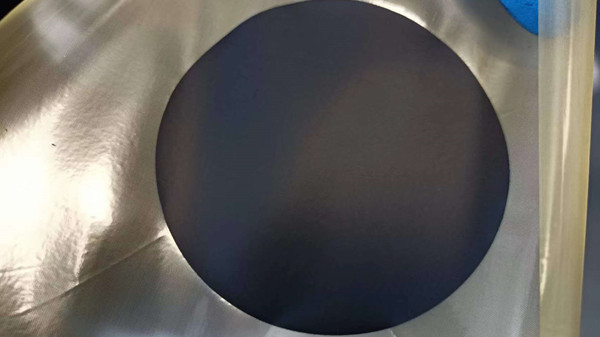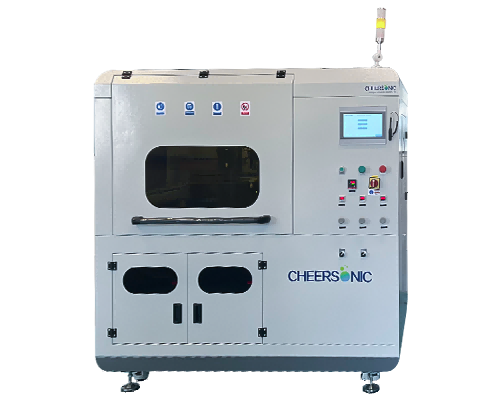Ultrasonic Coating Ion Exchange Membrane
Ion membrane electrolysis: technical insights and the innovative power of ultrasonic spraying
In the vast landscape of modern industrial technology, ion membrane electrolysis, as a cutting-edge and highly practical technology, is profoundly affecting many key areas. Ion membrane electrolysis, also known as membrane cell electrolysis, cleverly uses cation exchange membranes to accurately separate the unit electrolyzer into an anode chamber and a cathode chamber, thereby achieving effective separation of electrolysis products. This technology is rooted in ion exchange resin technology, but has achieved major breakthroughs. With its unique ion selective permeability, it has shown extraordinary application potential in many fields.
Ion exchange membranes, like an intelligent “ion gatekeeper”, show a high degree of selective permeability to anions and cations, allowing only ions of specific charges to shuttle through, while strictly guarding against ions of opposite charges. With this characteristic, ion membrane electrolysis has achieved a series of complex and critical industrial operation goals such as concentration, desalination, purification, purification, and electrochemical synthesis.
Diverse applications, outstanding results
Ion membrane electrolysis has been successfully implemented in many fields and shines brightly. In the field of chlor-alkali production, it has become a mainstay. The electrolysis of salt or potassium chloride aqueous solution through cation exchange membrane electrolyzers can efficiently produce chlorine, hydrogen and high-purity caustic soda (sodium hydroxide) or potassium hydroxide, which has greatly promoted the modernization of the chlor-alkali industry. In terms of water treatment, the desalination of seawater and brackish water cannot be separated from its help, providing a powerful means to alleviate the global shortage of fresh water resources; the preparation of industrial water and ultrapure water also relies on its technical advantages to ensure the high quality of production water. In the field of medicine, ion membrane electrolysis plays a key role in the refining process of drugs such as enzymes, vitamins and amino acids, ensuring the high purity and safety of drugs. In addition, the recycling of electroplating waste liquid and the proper treatment of radioactive wastewater can all be seen in the ion membrane electrolysis, among which the chlor-alkali industry is the field where it is most widely used and has the most significant results.
Fine process, efficient operation
The process of ion membrane electrolysis is rigorous and exquisite. The concentrated salt water solution, which has been carefully refined twice, flows continuously into the anode chamber. Under the strong force of the electric field, the sodium ions, like well-trained soldiers, uniformly pass through the cation exchange membrane and migrate rapidly to the cathode chamber. In the cathode chamber, the sodium ions successfully join forces with the hydroxide ions produced by the electrolysis of water at the cathode to form sodium hydroxide. At the same time, the cathode releases hydrogen. The chloride ions in the salt water solution are strictly restricted by the ion membrane and are difficult to enter the cathode chamber.
They can only accept the mission of oxidation at the anode and transform into chlorine. After part of the sodium chloride completes its electrolysis mission, the remaining light salt water leaves the electrolytic cell and returns to the anode chamber in high spirits after a series of processes such as removal of dissolved chlorine, re-saturation of solid salts, and re-refining, forming a salt water circulation loop similar to the mercury method. Part of the sodium hydroxide solution flowing out of the cathode chamber makes a glorious debut as a high-quality product, and the other part returns to the cathode chamber after adding pure water. The circulation of alkali solution is like the blood circulation of the human body. It not only accurately controls the amount of water added, but also cleverly takes away the heat generated inside the electrolytic cell, ensuring the stable and efficient operation of the entire system.
Strict requirements, quality first
As the core component of ion membrane electrolysis, the ion membrane shoulders a major mission, so there are extremely strict requirements for its performance. First, the cation selectivity must be outstanding to ensure that cations can pass smoothly and at the same time prevent the “cross-border” behavior of anions to the greatest extent. Secondly, the electrolyte diffusion rate should be low to reduce unnecessary material diffusion and ensure the efficiency and accuracy of the electrolysis process. Furthermore, the chemical stability and thermal stability should be high, so that it can always stick to its post and maintain stable performance under complex and changeable chemical environments and high temperature conditions. In addition, the mechanical strength should be high enough and not easy to deform to cope with various physical stresses in the electrolysis process.
Finally, the resistance should be small to reduce energy loss and improve energy utilization efficiency. Modern cation exchange membranes mostly use perfluorosulfonic acid-perfluorocarboxylic acid composite membranes reinforced with polyfluorocarbon fabrics. The side facing the anode is equipped with a sulfonic acid group with low resistance, just like the fast lane of a highway, which helps ions pass quickly; the side facing the cathode is a carboxylic acid group with low water content, which is like a loyal guard, effectively inhibiting the migration of hydroxide ions to the anode chamber and significantly improving the current efficiency. Some ion membranes have also been specially treated to have a rough surface or a microporous inorganic film. This ingenious design greatly increases the hydrophilicity of the perfluorocarboxylic acid membrane, making it difficult for hydrogen bubbles to remain on the membrane surface, removing obstacles for the smooth progress of the electrolysis process. This carefully designed ion membrane is perfectly adapted to the ion exchange membrane electrolyzer with a very small “zero” inter-electrode distance or “membrane” gap between the two electrodes.
Unique advantages, leading the future
Ion membrane electrolysis is unique in the industrial field with a series of outstanding advantages. Compared with diaphragm electrolysis and mercury electrolysis, it has the lowest total energy consumption. At a current density of 4000A/m, the DC power consumption per ton of caustic soda is only 7.56-7.92GJ (2100-2200kWh), which greatly reduces the production cost and conforms to the concept of sustainable development. The caustic soda produced is of extremely high purity. In 50% sodium hydroxide lye, the sodium chloride content is only 50-60ppm, which lays a solid foundation for the high-quality production of downstream products. More importantly, the ion membrane electrolysis method gets rid of the environmental pollution caused by mercury or asbestos, and is a veritable green environmental protection technology. In terms of operation and control, it also shows excellent convenience. Operators can easily control it, and it has a strong ability to adapt to load changes and can be flexibly adjusted according to production needs. However, the ion membrane electrolysis method also has certain limitations, such as extremely high requirements for brine quality and relatively expensive ion membranes.
In the early 1980s, advanced ion membranes were able to operate stably at a high current density of 4000A/m, with a current efficiency of up to 95% – 96%, and could even directly produce sodium hydroxide with a concentration of 35%, with a service life of about 2 years. In view of the many significant advantages of the ion membrane method, the ion membrane method will most likely be used as a priority for new chlor-alkali production facilities in the future. At the same time, a considerable number of existing mercury or diaphragm chlor-alkali plants will actively embrace the ion membrane method during technological transformation.
Ultrasonic spraying: injecting new vitality into ion membranes
In the process of ion membrane preparation and performance optimization, ultrasonic spraying technology is like a bright new star, rising slowly, showing incomparable advantages.
Optimizing the microstructure of the membrane surface
Ultrasonic spraying can accurately spray a layer of nanomaterials with specific functions on the surface of the ion membrane. The high-frequency vibration of ultrasound, like a “symphony” in the microscopic world, causes the spraying material to cover the surface of the ion membrane gently and orderly in an extremely fine and uniform particle state. For the ion membrane, this process is like a fine “carving” of its surface microstructure. By spraying a layer of nano-scale proton conductive material, the ion conduction channel can be significantly optimized, the passage of cations can be smoother, the membrane resistance can be effectively reduced, and the ion conduction efficiency can be greatly improved. This can greatly improve the current efficiency and reduce energy consumption in the electrolysis process of the chlor-alkali industry, bringing considerable economic benefits to the enterprise.
Enhance the comprehensive performance stability of the membrane
In actual industrial applications, ion membranes often face challenges from various harsh environments, and harsh conditions such as high temperature, high humidity, and strong chemical corrosion emerge in an endless stream. Ultrasonic spraying technology can carefully construct a solid protective coating on the surface of the ion membrane. In a high-temperature environment, spraying a layer of high-temperature resistant and anti-oxidation coating is like putting a solid “armor” on the ion membrane, effectively resisting the invasion of high-temperature oxidation and significantly extending the service life of the ion membrane. In a high-humidity environment, a coating with waterproof and moisture-proof functions is like a “protective umbrella” to prevent the ion membrane from degrading due to excessive water absorption. For application scenarios that are prone to chemical corrosion, such as chemical wastewater treatment, corrosion-resistant coatings can stand up and greatly enhance the chemical corrosion resistance of ion membranes, ensuring that they can still operate stably and efficiently in harsh chemical environments.
Improve the compatibility of membranes and electrolyzer components
During the operation of ion membrane electrolyzers, ion membranes need to work closely with many components such as electrodes. Ultrasonic spraying technology can spray an interface layer with specific functions on the surface of the ion membrane. This interface layer is like a “bridge” for communication, which greatly improves the compatibility between the ion membrane and other components. By spraying a layer of interface layer material with good conductivity and adhesion, the electronic conduction and physical connection between the ion membrane and the electrode can be significantly enhanced, and the contact resistance can be greatly reduced, thereby improving the operating efficiency of the entire electrodialysis device. At the same time, this interface layer can also play a buffering role, cleverly reducing the stress concentration caused by factors such as differences in thermal expansion coefficients between different components, just like injecting a dose of “stable heart shot” into the entire system, significantly improving the stability and reliability of the system.
In summary, ion membrane electrolysis occupies a pivotal position in modern industry with its unique technical charm and broad application prospects. The strong intervention of ultrasonic spraying technology has opened up a new path for the performance improvement and application expansion of ion membranes, and is expected to promote technological breakthroughs and innovative applications of ion membrane electrolysis in more fields, further demonstrating its core value in the development of modern industry and science and technology.
About Cheersonic
Cheersonic is the leading developer and manufacturer of ultrasonic coating systems for applying precise, thin film coatings to protect, strengthen or smooth surfaces on parts and components for the microelectronics/electronics, alternative energy, medical and industrial markets, including specialized glass applications in construction and automotive.
Our coating solutions are environmentally-friendly, efficient and highly reliable, and enable dramatic reductions in overspray, savings in raw material, water and energy usage and provide improved process repeatability, transfer efficiency, high uniformity and reduced emissions.
Chinese Website: Cheersonic Provides Professional Coating Solutions



